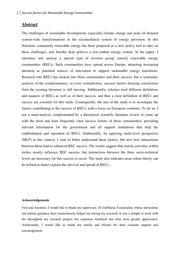File:Constantina Zardi.pdf
From energypedia
 Size of this JPG preview of this PDF file: 424 × 600 pixels. Other resolution: 170 × 240 pixels. |
Original file (2,480 × 3,508 pixels, file size: 0 bytes, MIME type: application/pdf, 62 pages)
Summary
| Description |
English: The challenges of sustainable development, especially climate change and peak oil demand system-wide transformations in the sociotechnical system of energy provision. In this direction, community renewable energy has been proposed as a new policy tool to take on these challenges, and thereby help achieve a low-carbon energy system. In the paper, I introduce and analyse a special type of investor group, namely renewable energy communities (RECs). Such communities have spread across Europe, attracting increasing attention as potential sources of innovation to support sustainable energy transitions. Research into RECs has looked into these communities and their success, but a systematic analysis of the complementary, or even contradictory, success factors drawing conclusions from the existing literature is still missing. Additionally, scholars used different definitions and nuances of RECs as well as of their success, and thus a clear definition of RECs and success are essential for this study. Consequently, the aim of the study is to investigate the factors contributing to the success of RECs, with a focus on European countries. To do so, I use a meta-analysis complemented by a theoretical scientific literature review to come up with the most and least frequently cited success factors of these communities, providing relevant information for the government and all support institutions that help the establishment and operation of RECs. Additionally, by applying multi-level perspective (MLP) to this context, I seek to better understand these factors, but also how interactions between them lead to enhanced REC success. The results suggest that mainly activities within niches mostly influence REC success, but interactions between the three socio-technical levels are necessary for this success to occur. The study also indicates areas where theory can be refined to better explain the survival and spread of RECs.
|
|---|---|
| Source |
VU University Amsterdam |
| Date |
2015-06-01 |
| Author |
Costantina Zardi |
| Permission |
See license tag below. |
Licensing
| This file is licensed under the Creative CommonsAttribution-NonCommercial 3.0 International license. | ||
|
File history
Click on a date/time to view the file as it appeared at that time.
| Date/Time | Thumbnail | Dimensions | User | Comment | |
|---|---|---|---|---|---|
| current | 14:16, 7 March 2016 |  | 2,480 × 3,508, 62 pages (0 bytes) | ***** (***** | *****) | User created page with UploadWizard |
You cannot overwrite this file.
File usage
There are no pages that use this file.





















